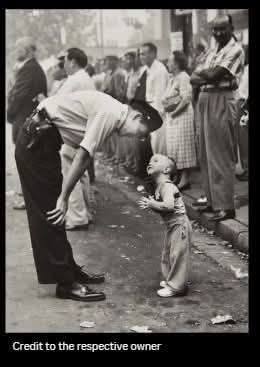On a warm, late summer day in 1957, William C. Beall stepped into a familiar role. He was covering a local parade for the Washington Daily News, camera slung over his shoulder, eyes scanning for scenes of life unfolding. The parade was organized by the Chinese Merchants Association, and around him dancers, drummers, swirling dragon costumes, and colorful pageantry marched along streets lined with spectators.
Beall had photographed parades many times before, chasing motion, color, faces, the rhythm of celebration. But on this particular September day, amid the vibrant pageantry, something quieter drew his attention.
A child, a street, and a moment of pure wonder
Just outside the official parade route, a young boy — small, curious, and perhaps a little lost in the spectacle — stepped off the curb. The power of the day’s energy, the drums, the colors: they beckoned to him. His gaze was fixed on the dancers, the dragon’s head, the beat of the drums. He wandered forward, a few tentative steps toward the street, as though pulled by the lure of excitement.
At that moment, a tall police officer nearby moved in. But he didn’t approach with command or sternness. Instead, he leaned down, reaching a hand toward the boy. His posture was protective, his gesture gentle — bridging the line between rules and innocence.

Beall saw the scene: child, officer, street — a quiet tension present in the air. He raised his camera. He clicked.
That click, in an instant, froze more than a visual image. It froze empathy, contrast, trust, care.
The photograph: more than a picture
The photograph later became known as “Faith and Confidence.” To many who have seen it over the decades, it is not just a record of a parade day. It is testimony — a reminder that sometimes, in an era of rules and structures, small gestures can speak most loudly.
Beall, in later reflections, said it was not a planned moment. He didn’t stage it. He simply recognized something universal: a child drawn by curiosity and an adult guiding with kindness.
In 1958, “Faith and Confidence” earned him the Pulitzer Prize. The judging panel recognized not only the technical quality of the image, but its resonance, its emotional weight.
Why that moment still matters
Decades later, the photograph still speaks. It no longer just belongs to the archives of journalistic awards — it belongs to the quiet catalog of human connection. Here’s what lingers:
- Innocence and curiosity: The child’s steps, drawn forward by wonder, remind us that discovery is a core part of being alive — especially in youth.
- Protective presence: The officer’s gesture isn’t force. It’s care. It shows that authority can become humanity, that strength can express softness.
- Suspended time: Because of that click, a split second became permanent. We are allowed to pause, to reflect, to feel what was happening between two people in a public place.
- Resonance across eras: The image traveled beyond its moment. In a world that often demands attention by volume — bold headlines, grand conflicts — this photograph asks us to listen to quieter signals.
Many years have passed. Parades have changed. Cameras have evolved. Streets have transformed. Yet, the tension between rules and wonder, between authority and vulnerability — that tension remains.
In the frame, we find ourselves
When I look at “Faith and Confidence,” I don’t see a vintage newspaper shot. I see something alive. I see a child, wide-eyed, drawn by life’s spectacles. I see an adult offering guidance, compassion, as a bridge between curiosity and safety.
And I see the world paused — just for a breath.
In our daily rush, how many moments like that slip unnoticed? How many children wander after wonder? How many hands reach — not to restrict, but to protect?
This photograph remains more than a historical artifact. It remains a question: What gestures of care do we allow ourselves to notice, to act upon, to preserve?
That single shutter click in September 1957 reminds us that sometimes the simplest scenes carry the deepest stories.